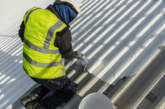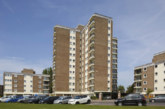It is important for building owners to recognise the risks associated with working at height. Tom Kerr runs through some of the factors that building owners need to consider to protect themselves and to ensure that those on site have the necessary skills and knowledge to carry out works safely.
Working at height can pose a real risk to operatives at all stages of a project — from when the initial roof survey and project scope is created, through to the completion of the project and any on-going maintenance. According to HSE research, working at height is the most common cause of fatal accidents to workers (26%) and ‘over 60% of deaths during work at height involve falls from ladders, scaffolds, working platforms, roof edges and through fragile roofs or rooflights’. It is therefore important for building owners and managers to ensure safety on site. Equally, the employer of the visitor must ensure staff have the necessary credentials to attend the site and work safely, and have risk assessments in place to cover their activities.
When working with third parties, consider the following:
- Does the company have a Safe Survey Policy?
Those managing the building should feel assured that fully competent individuals are carrying out any works at height, working collaboratively with relevant stakeholders and following protocol, to support a risk-free partnership.
Langley’s Safe Survey Policy is a good example of a best practice approach to this, as it provides clear guidance on the way any works will be planned, organised and ultimately carried out by its employees and associated third parties — and details the health and safety protocols to which their employees have to adhere.
- Does the company have comprehensive health and safety training records?
It is important that building owners and managers ask for proof that individuals working on site have received the correct health and safety training, and are therefore, up to speed with the relevant practices — especially for working at height.
Recognised and formal training certifications include completing an IOSH (Institute of Occupational Health and Safety) course. It is important that courses such as this are supported by internal company training and completed regularly to ensure practices are up to date. Internal training should cover topics such as undertaking risk assessments, safely working at height, use of ladders, scaffolding and harnesses.
- Can the company prove their employees are competent?
According to the HSE: “A competent person is someone who has sufficient training and experience or knowledge and other qualities that allow them to assist you properly.” The HSE also states that the complexity of the situation will determine the level of competence required for someone to complete a task. Due to the associated risks, it is important that those working at height be highly competent.
Although it is not a legislative requirement, it is important for individuals to hold a valid Construction Skills Certification Scheme (CSCS) card, which shows that the person has received the minimum training to work on a construction site. For further reassurance, building owners and premises managers should look for third parties that hold accreditations such as the Contractors Health and Safety Assessment Scheme (CHAS), SMAS, CCS, the Royal Society for the Prevention of Accidents (RoSPA) and Safe Contractor. These indicate that a company not only cares for employee wellbeing, but that it is dedicated to raising its health and safety standards.
- Have the companies’ employees received all the relevant checks?
When working in premises such as schools or hospitals, any visitors working on site are likely to need a DBS certification. It is important that building owners and premises managers see proof of this. For example, all of Langley’s surveyors have advanced DBS checks and carry these when surveying.
These aspects of health and safety should be considered before third parties enter site and start initial inspections — not only because building owners can be liable for the health and safety of those on site, but also to minimise risk.
It is important to work with third parties such as suppliers or contractors that have appropriate accreditation, memberships and stringent policies in place, and provide regular safety training to fully equip their employees with the correct qualifications. By doing so building owners can be confident that the necessary steps have been taken to reduce risk and therefore support a risk-free partnership throughout the project.
Tom Kerr is Sales Director at Langley









